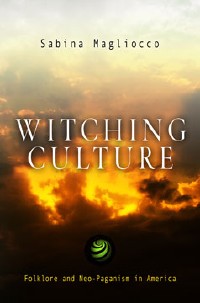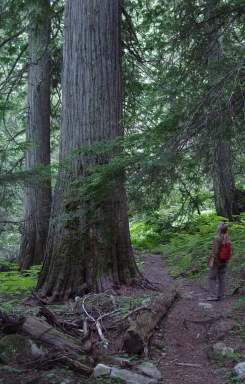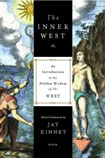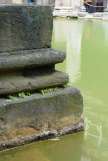Part 1 Part 2 Part 3At today's exchange rate, it costs US $16.38 to tour the excavated ruins of the
Roman baths that give Bath its name. I paid the entry fee twice, last Sunday and last Monday. It was worth it.

Full of tourists as it is, the place still has a presence. Celtic British holy site, Roman temple-baths complex,
Dark Ages ruin, medieval hospital for "leprosy" (whatever they meant by that term back then--any skin disease, apparently), 18th-century fashionable watering hole . . . layers on layers. And underneath it all the sacred spring still flows, 13 liters per second, or 250,000 gallons per day, however you wish to measure it.
LEFT: Diorama of a Roman priest with two visitors to the temple-baths complex. The temple of Minerva Sulis is in the background.I had stayed at the
White Hart Inn with seven friends; six returned to their homes in the UK after the conference, leaving just
Doug Ezzy and me (the "rude colonials"), so we found new lodgings nearby at
No. 3 Caroline Buildings and stayed on. After a "full English breakfast" on Sunday the 27th of June (a meal that seems always to include baked beans--I had forgotten that), we walked to the site of the baths.
They give you one of those audio guide receivers to listen to, as many museums do. Its soundtrack is a little too fond of Roman trumpet blasts, but they also include, for instance, the screamed Latin curse of a woman throwing a scrap of lead with a curse written on it into the sacred spring. Folks used to do that a lot, along with their votive offerings.
By the time I arrived at the dedicatory altars (placed in the sanctuary in fulfillment of someone's vow) and the tombstones, I was
there. I don't mean some big reincarnational flashback; I've had those (maybe), and this was not the same. But I half-lost track of Doug, and the clusters of tourists were in the background. Here, underground as the site now is, I was ready to do it all: to cast my offerings into the water (still done), pay honor to Minerva Sulis (yes), and then submerge myself (sorry, not permitted). Only a clandestine dip of fingers, in defiance of the posted notice (not sanitary!).
Instead, the nearest thing is to go upstairs into the 18th-century
Pump Room and to pay 50 pence (90 cents) to a man in wig and knee britches who decorously passes you a glass tumbler full of the water, tasting of rust and sulfur, and drink it down, down, down.
Not enough. Doug and I left to have a quick pint of the local
Blackthorn cider with
Alan Richardson and his lady friend, Margaret--Alan's new biography of the magician William Gray,
The Old Sod, was recently published by
Ignotus Press. And Doug went on to continue his interview of British teen witches for a study that he is conducting together with
Helen Berger. And I was up the next morning and back to the Roman baths.
I let the audio receiver hang from its cord, instead just walking the ancient pavements, listening, looking, feeling. And taking pictures. Maybe taking pictures is a votive act itself, sometimes--perhaps there is a paper there or at least a couple of paragraphs. No doubt, had the Empire lasted, the priests of Sulis would be selling disposable cameras at a stall in the temple courtyard--or they would have leased the concession to someone else to do it. Pagan religions, after all, delight in the tangible. The relic, the souvenir--that is one of the Pagan substrata that underly the so-called world religions. We want to experience the gods with all our senses, so a soak would have been nice too. Instead, you get the T-shirts and the
Aquae Sulis bath products in the museum shop. Oh well, it's a handsome T-shirt.
This
3.1 MB video clip pans across the Roman pool (facing east), showing the 19th-century terrace above the pool with Victorian statuary, various tourists, and a glimpse of the abbey in the background.
This
1.4 MB video clip pans from the opposite side, looking down into the entrance to the West Baths.
And then on to Bristol, for a too-short, 24-hour visit with
Ronald Hutton, and then bus-bus-airplane-airplane-Jeep and home.
Labels: England, Paganism, travel
 Back at my campus office, I discovered a review copy of
Back at my campus office, I discovered a review copy of  We go to British Columbia to see the big trees, like this Western red cedar in
We go to British Columbia to see the big trees, like this Western red cedar in  The collection of 20 articles is drawn mostly from the back issues of
The collection of 20 articles is drawn mostly from the back issues of  While I was in England, M. was Web-searching and turned up the Duchess of Northumberland's "poison garden," which I would like to see today. Part of a much larger
While I was in England, M. was Web-searching and turned up the Duchess of Northumberland's "poison garden," which I would like to see today. Part of a much larger  Of course, people visit exhibition gardens to get ideas. If, for instance, the duchess gets official approval to grow coca (and being a young, media-savvy duchess she might well get it), others might well think, "I could plant some of that between the rhododendrons."
Of course, people visit exhibition gardens to get ideas. If, for instance, the duchess gets official approval to grow coca (and being a young, media-savvy duchess she might well get it), others might well think, "I could plant some of that between the rhododendrons."
 Full of tourists as it is, the place still has a presence. Celtic British holy site, Roman temple-baths complex,
Full of tourists as it is, the place still has a presence. Celtic British holy site, Roman temple-baths complex, 
 Back from England, I am planning several blog posts as I edit the photos and video clips to go with them.
Back from England, I am planning several blog posts as I edit the photos and video clips to go with them. 

